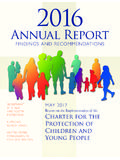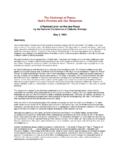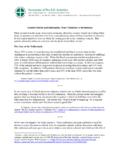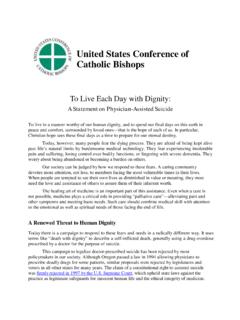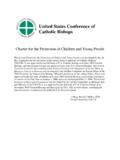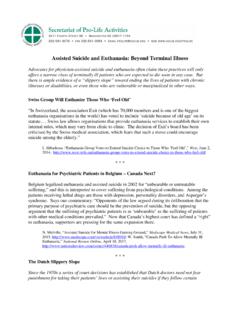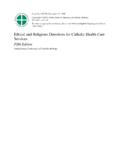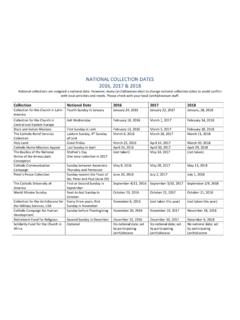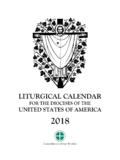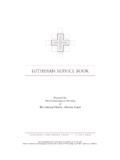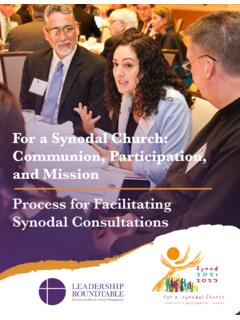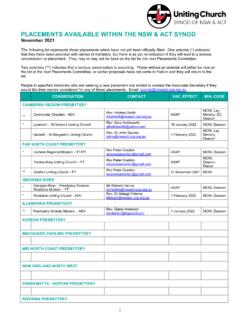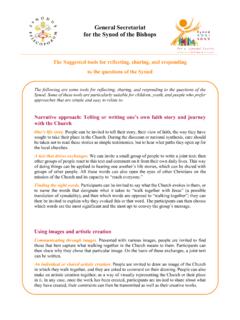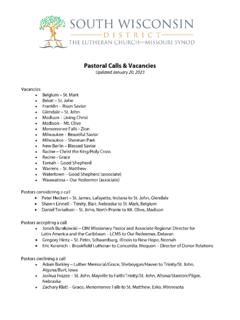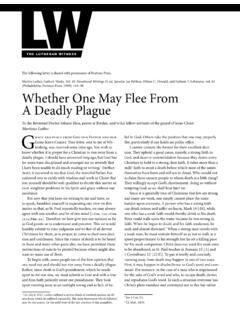Transcription of For a Synodal Church
1 Official Handbook for Listening and Discernment in Local Churches:First Phase [October 2021 April 2022]in Dioceses and Bishops ConferencesLeading up to the Assembly of Bishops in synod in October 2023 synod OF BISHOPSVADEMECUMFOR THE synod ON SYNODALITYFor a Synodal Church : Communion, Participation, and MissionPublished by Secretary General of the synod of BishopsVia della Conciliazione 34, Vatican CitySeptember 2021 AbbreviationsDV VATICAN COUNCIL II, Dogm. Const. Dei Verbum (18 November 1965)EC FRANCIS, Ap. Const. Episcopalis communio (15 September 2018)FT FRANCIS, Encyclical Letter Fratelli tutti (3 October 2020)GS VATICAN COUNCIL II, Pastoral Const. Gaudium et spes (7 December 1965)ITC, Sync International Theological Commission, Synodality in the life and mission of the Church (2 March 2018)LG VATICAN COUNCIL II, Dogm.
2 Const. Lumen gentium (21 November 1964)PD Preparatory DocumentRM JOHN PAUL II, Encyclical Letter Redemptoris Missio (7 December 1990)Prayer for the synod : Adsumus Sancte Spiritus Every session of the Second Vatican Council began with the prayer Adsumus Sancte Spiritus, the first word of the original Latin, meaning, We stand before You, Holy Spirit, which has been historically used at Councils, Synods and other Church gatherings for hundreds of years, and is attributed to Saint Isidore of Seville (c. 560 - 4 April 636). As we embrace this Synodal Process, this prayer invites the Holy Spirit to be at work in us so that we may be a community and a people of grace. For the Synodal journey from 2021 to 2023, we propose to the following simplified version,1 so that any group or liturgical assembly can pray it more easily. 1 The original version of the Adsumus Sancte Spiritus can be found on the synod stand before You, Holy Spirit,as we gather together in Your You alone to guide us,make Yourself at home in our hearts;Teach us the way we must goand how we are to pursue are weak and sinful;do not let us promote not let ignorance lead us down the wrong pathnor partiality influence our us find in You our unityso that we may journey together to eternal lifeand not stray from the way of truthand what is this we ask of You,who are at work in every place and time,in the communion of the Father and the Son,forever and DOCUMENT1.
3 Introduction What is the purpose of this Vademecum? What is Synodality? Background for this synod What is the aim of this synod ? Objectives of the Synodal Process The theme for this synod : Towards a Synodal Church : Communion, Participation, and Mission The Experience on the Local Level2. Principles of a Synodal Process Who can participate? A process that is truly Synodal : Listening, Discernment, and Participation Attitudes for Participating in the Synodal Process Avoiding Pitfalls3. The Process of the synod The Diocesan Phase The role of Episcopal Conferences and Synods of Oriental Churches The Continental Phase The Assembly of the synod of Bishops4. Travelling the Synodal Path in Dioceses Summary of what is Envisaged in the Diocesan Phase The Role of the Bishop during the Synodal Process The Role of Priests and Deacons The Roadmap (Sample Steps for the Diocesan Phase) The Basic Ingredients of the Synodal Process5.
4 Resources for organizing the Synodal Process Methodology for the Diocesan Synodal Process The Informal Dimension of the Synodal Process The Main Questions for ConsultationA Word of GratitudeTable of ContentsNOTE: This Vademecum is intended to be used by the entire Catholic Church . Therefore, local Church refers interchangeably to a diocese, an eparchy, an ordinariate, or any equivalent ecclesial body. Likewise, where this Vademecum uses the term episcopal conference, this corresponds to the relevant Synodal institution of each Church sui (A) The Diocesan Contact Person(s)/Team a. The role and responsibilities of the Diocesan Contact Person(s)/Team b. The qualities of the Diocesan Contact Person(s)(B) Suggested Guide for Organizing a Synodal Consultation Meeting(C) Diocesan Pre- Synodal Meeting a. Introduction b. Objectives c.
5 Participants d. Agenda and form e. Possibility of conducting online or hybrid Synodal meetings (e- Synodal meetings) f. Role of young people in online or hybrid meetings (e- Synodal meetings)(D) Preparing the Diocesan Synthesis a. What kind of feedback/response is expected in the diocesan synthesis? Transmitting the fruits and diversity of the Synodal experience b. Suggested questions to guide the diocesan synthesis c. Implementing the fruits of the diocesan synthesis in the local ChurchRESOURCES FOR ORGANIZING THE Synodal PROCESS I. Glossary of Terms II. More Consultation Questions to Guide the Synodal Process III. Involving Various Groups in the Synodal Process IV. Guidelines and Tips for Listening at the Local Level V. Biblical resources VI. Liturgical resources VII. Excerpts from Relevant Church Documents VIII.
6 The Meaning of Consensus in the Synodal ProcessSynod FAQs (Frequently Asked Questions)1. IntroductionThis Vademecum is designed as a handbook that accompanies the Preparatory Document at the service of the Synodal journey. The two documents are complementary and should be read in tandem with one another. In particular, the Vademecum offers practical support to the Diocesan Contact Person(s) (or team), designated by the diocesan Bishop, to prepare and gather the People of God so that they can give voice to their experience in their local Church . This worldwide invitation to all the faithful is the first phase of the XVI Ordinary General Assembly of the synod of Bishops, whose theme is For a Synodal Church : communion, participation and mission. In creating the opportunity for listening and dialogue on the local level through this synod , Pope Francis is calling the Church to rediscover its deeply Synodal nature.
7 This rediscovery of the Synodal roots of the Church will involve a process of humbly learning together how God is calling us to be as the Church in the third millennium. This handbook is offered as a guide to support each local Church s efforts, not as a rulebook. Those who are responsible for organizing the process of listening and dialogue at the local level are encouraged to be sensitive to their own culture and context, resources, and constraints, and to discern how to implement this diocesan Synodal phase, guided by their diocesan Bishop. We encourage you to take useful ideas from this guide, but also to have your own local circumstances as your starting point. New and creative pathways may be found for working together among parishes and dioceses in order to bring this Synodal Process to fruition. This Synodal Process need not be seen as an overwhelming burden that competes with local pastoral care.
8 Rather, it is an opportunity to foster the Synodal and pastoral conversion of each local Church so as to be more fruitful in mission. Many regions already have established processes for engaging with the faithful at the level of their parishes, movements, and dioceses. We are conscious that there are a number of countries where the local Church has initiated a Synodal conversation of its own, including the Ecclesial Assembly in Latin America and the Caribbean, the Plenary Council in Australia, and the Synodal journeys in Germany and Ireland. There are also many diocesan synods that have taken place all over the world, including several that are currently underway. These regions and dioceses are called to creatively articulate the Synodal processes already underway with the phases of the current synod taking place across the entire Church .
9 For certain other regions, What is the purpose of this Vademecum?the experience of this Synodal Process is new and uncharted territory. Our intention is that the resources offered through this Vademecum might provide helpful tools at the service of all, by proposing good and fruitful practices that can be adapted along the way as we journey together. In addition to this handbook, the Vademecum includes: a) online liturgical, biblical, and prayer resources, as well as b) more detailed methodological suggestions and tools, c) examples from recent Synodal exercises, and d) a Glossary of Terms for the Synodal Process. It is especially important that this listening process happen in a spiritual setting that supports openness in sharing as well as hearing. For this reason, you are encouraged to root the local experience of the Synodal Process in meditation on Scripture, the liturgy, and prayer.
10 In this way, our journey of listening to one another can be an authentic experience of discerning the voice of the Holy Spirit. Authentic discernment is made possible where there is time for deep reflection and a spirit of mutual trust, common faith, and a shared Preparatory Document reminds us of the context in which this synod is taking place a global pandemic, local and international conflicts, growing impact of climate change, migration, various forms of injustice, racism, violence, persecution, and increasing inequalities across humanity, to name a few. In the Church , the context is also marked by the suffering experienced by minors and vulnerable people due to sexual abuse, the abuse of power, and the abuse of conscience perpetrated by a significant number of clerics and consecrated persons. 2 With all this being said, we find ourselves at a crucial moment in the life of the Church and the world.
